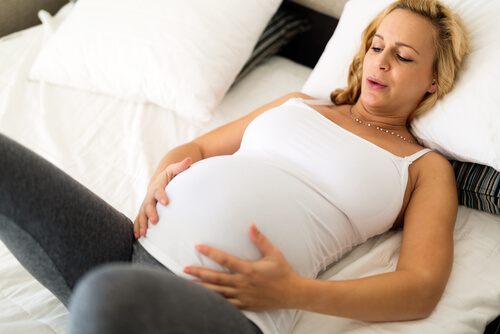4 Breathing Techniques during Delivery

From the moment delivery begins, breathing is fundamental for enduring until the baby is born. Breathing techniques during delivery not only help the mother during labor, but also benefit the baby’s oxygenation.
Among other benefits, breathing techniques during delivery activate the circulatory system. Additionally, keeping your muscles tense while doing these exercises elevates your cardio-respiratory activity and helps you control pain and recharge energy.
How to Breathe during Delivery
Some specialists believe that breathing is a spontaneous process that mothers acquire during delivery. However, there are a few basic techniques that maternity courses teach.
To be effective, breathing techniques during delivery maintain a breathing pattern. Then the father or assistants accompany the mother in her breathing process.
The best way to follow a breathing pattern is to watch someone while they apply the technique. Following the pattern with someone else helps the mother stay focused.

On the other hand, losing control of her breathing during the birth process creates stress and anxiety for a mother. Lack of control leads to panicked breathing. Short, uncontrolled breaths can cause hyperventilating or fainting.
Breathing Techniques during Delivery
During delivery, breathing techniques set the pace during this important moment. Additionally, they help provide the energy necessary for the moment of birth.
Slow or Abdominal Breathing
When the contractions begin, apply slow or abdominal breathing. This consists of taking deep breaths through the nose, inflating your abdomen.
Then breathe out through your mouth. The exhalation should be longer than the inhalation, and you should pause for a few seconds between breaths.
The purpose is to follow the rhythm of the contractions and to control the pain.
Light, Fast Breaths
As the contractions continue, it’s normal for your breathing to accelerate. Some specialists call this Light Accelerated Breathing. They are slightly shorter breaths, but they continue the nose-mouth pattern.
Take in a small amount of air through your nose when the contraction starts, then breathe out through your mouth as it ends. You can breathe out all at once, or in four parts.
If the contractions increase, breathe at the torso or chest level. These shorter breaths increase the amount of oxygen the baby gets and also help to control the pain.
Panting or Variable Breathing
This is used while waiting for full dilation. It helps to avoid the sensation of pushing.
It consists of very short breaths through the nose and mouth. It is also known as “Hee Hoo” or “pant-pant-blow.”
Breathe in through your nose as the contraction begins, then exhale sharply twice, pronouncing the syllable “hee” each time, followed by a long exhalation, with a prolonged syllable “hoo.”

This technique should be applied with the mother in a comfortable position to avoid hyperventilation. You should also keep your chin elevated, blowing forward to avoid pushing.
Expulsion or Pushing Breaths
This is the last breathing technique for delivery. When she reaches this point, a mother is ready to give birth to her baby.
Take a large breath, filling your lungs. When you feel the need to push, tip your chin towards your chest.
Next, raise your legs and push, letting the air out little by little. Finally, breathe in and out normally to get your breath back. You can repeat this as many as three times to recharge your energy for the next push.
While pushing, the mother should try to relax her pelvis. This will help to expel the baby. It’s important to avoid holding your breath when it’s time to push. This can cause damage to the pelvic floor and inhibit the flow of oxygen to the baby
Pushing should last 5 to 6 seconds. The mother’s partner or the specialist can count the time.
It’s a good idea to practice breathing techniques before the due date. It’s also a good idea to use breathing patterns for relaxation during pregnancy.
Standing in front of a mirror to practice these techniques will help you focus, maintain the pattern, and be conscious of the breaths you take.
All cited sources were thoroughly reviewed by our team to ensure their quality, reliability, currency, and validity. The bibliography of this article was considered reliable and of academic or scientific accuracy.
- Kamalifard, Mahin et al. “The efficacy of massage therapy and breathing techniques on pain intensity and physiological responses to labor pain.” Journal of caring sciences vol. 1,2 73-8. 27 May. 2012, doi:10.5681/jcs.2012.011
- Lothian, Judith A. “Lamaze breathing: what every pregnant woman needs to know.” The Journal of perinatal education vol. 20,2 (2011): 118-20. doi:10.1891/1058-1243.20.2.118
- Yuksel, Hilal & Cayir, Yasemin & Kosan, Zahide & Taştan, Kenan. (2017). Effectiveness of breathing exercises during the second stage of labor on labor pain and duration: a randomized controlled trial. Journal of Integrative Medicine. 15. 456-461. 10.1016/S2095-4964(17)60368-6.
This text is provided for informational purposes only and does not replace consultation with a professional. If in doubt, consult your specialist.
